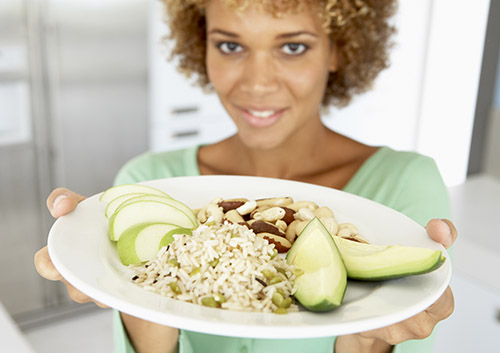Bright Ideas for Your Smile
December 25th, 2025

Keeping your smile its brightest can be a challenge! The foods you eat, healthy habits, unhealthy habits, and time itself can affect the color of your enamel. Luckily, there are some everyday actions you can take to minimize staining and discoloration.
- Limit “Food Coloring”
Some of our favorite foods and beverages cause some of the most noticeable staining. Even though enamel is the strongest substance in our bodies, it’s still porous. This means that enamel can absorb elements from our foods, including tannins and natural food colors, which darken teeth over time.
That’s why a daily cup of coffee or tea, or a glass of red wine with dinner, or frequent helpings of dark berries, can lead to a less than brilliant smile in a matter of months. What’s more, acidic foods like citrus fruits, pickled foods, and sodas erode the enamel surface, which makes it easier for food stains to penetrate.
When you eat those smile-dimming foods, it’s a good idea to rinse with water right away. (When tasty treats are acidic, it’s best to wait to brush for about half an hour to avoid enamel damage.) And here’s a simple work-around—use a straw when you enjoy discoloring drinks.
You can also reduce staining by adding food allies to your diet. Besides bringing you the nutritional benefits of a healthy, well-balanced diet, crunchy foods such as apples, carrots, and celery can have a mild scrubbing effect on the tooth surface, and dairy foods strengthen enamel and might help prevent staining when added to coffee or tea.
If you’re mindful of your eating habits, you’ll help your smile stay its brightest. And speaking of habits . . .
- Keep Up with Healthy Habits
Plaque is a sticky biofilm which contains oral bacteria, food particles, saliva, and fluids. This film starts forming within hours after brushing, and a buildup of plaque leaves teeth looking yellowish. If plaque is left undisturbed, it hardens into tartar within days. And the yellow and brown colors of tartar aren’t a flattering look for any of us.
Regular brushing and flossing is the best way to keep your teeth plaque-free. For a brighter smile, a whitening toothpaste can help remove superficial surface stains. But what a whitening toothpaste can’t do is to remove deep staining or tartar.
A professional cleaning every time you have a checkup at our Anthem office is the best way to keep your teeth their cleanest, especially because tartar must be removed by a dental professional. And please feel free to ask for brushing and flossing tips to help maintain your sparkling smile.
- Give Up Unhealthy Habits
Cigarettes, cigars, and other forms of tobacco are terrible for your health and terrible for your smile. While cosmetic concerns are the least of our worries when it comes to tobacco, it’s well known that smoking and chewing tobacco cause unattractive yellow and brown staining.
Quitting tobacco in any form benefits not just your appearance, but your oral health—and your overall health. When you’re ready, talk to Drs. Peter Vogel, Vijal Vadecha about some of the methods you can use to give up the habit permanently.
- Beat the Clock
Over the years, erosion and wear cause the enamel layer on the outside of the tooth to thin or crack. This allows the dentin underneath to show through. Because dentin is darker than enamel to begin with, and gets darker over time, teeth can take on a yellow or grey hue as we age.
Keep your smile looking its best through the years with regular checkups and cleanings. Avoid excessive erosion and abrasion by being mindful of the acidic foods in your diet, using a soft-bristled brush for cleaning your teeth, and getting treatment for harmful conditions like bruxism (tooth grinding). If you notice any changes in your smile, it’s a good idea to talk to Drs. Peter Vogel, Vijal Vadecha.
While preventing staining naturally with diet and healthy habits is great, sometimes nature needs a nudge. If you have an important event coming up, or if you would simply like to feel more confident about your smile, talk to us about professional whitening. A professional treatment uses a stronger whitening formula, and often works more quickly, is more effective at removing yellowing and stains, and lasts longer than home treatments.
Finally, while you can do a lot to keep your teeth their brightest by preventing and treating external staining, other types of discoloration can also affect your teeth. For staining caused by medication, root canal work, or trauma, ask us about all the options available to you.
Yes, keeping your teeth their brightest can be a challenge, but doing your part—and working with your dental team at Daisy Mountain Dentistry—will make sure you greet the world with a sparkling, confident smile.
Can Superfoods Create a Super Smile?
December 18th, 2025

It’s a rare week that we don’t hear something about superfoods—those foods which will transform our diets and radically improve our health. Remember kale? All the kale? (But, more on kale later!)
So, what exactly are “superfoods”? Unfortunately, we don’t have an exact answer for you, because, while the term “superfood” sounds impressive, it really doesn’t have an exact scientific meaning. Any food which is nutritionally dense with antioxidants, vitamins, minerals, healthy fats and/or other nutrients is often called a superfood.
Can these so-called “superfoods” help improve our dental health? The short answer: Yes! Let’s look at the benefits of some current popular superfoods, and just why they’re so good for our teeth and gums.
- Berries
Blueberries, strawberries, raspberries, and cranberries are not only delicious, but a rich source of antioxidants, minerals, and vitamins, including vitamin C. What does this mean for your dental health? Vitamin C is essential for healthy gums. In fact, one of the symptoms of vitamin C deficiency is swollen and bleeding gums.
- Salmon
“Good fat” seems like a dietary contradiction, but salmon is here to prove it’s possible. Omega-3 fatty acids have been linked to numerous health benefits, including fighting inflammation. Research has shown a possible relationship between getting the recommended amounts of omega-3s and a reduced risk of gum disease.
- Ancient Grains
Ancient grains are grains (and certain grasses and seeds) which have been cultivated the same way over the centuries. And even though these grains have been around for hundreds of years, many cooks are just starting to incorporate foods like quinoa, millet, farro, and freekeh into their recipes. Ancient grains are considered especially healthy because they are whole grains, with their nutrients, bran, and fiber intact. Processing grains removes many of these good-for-your-body elements.
And how does this processing affect our teeth? Whole grain carbs take time to break down and convert into the sugars which fuel our bodies. Processed grains used in foods like soft white breads and white rice start to break down quickly right in the mouth. They also tend to stick to the teeth, providing a rich supply of sugar to feed the oral bacteria which cause cavities. But you don’t need ancient grains to reap the benefits of whole grains—consider substituting whole wheat, brown rice, or whole grain corn for some of the processed grains in your diet.
- Yogurt
Most yogurt, unlike other dairy products, contains probiotics, which help supply our bodies with healthy bacteria. Most yogurt, like other fortified dairy products, is also rich in vitamin D. Vitamin D is essential for tooth health because it allows our bodies to absorb the calcium which keeps bones and teeth strong.
- Kale
We couldn’t leave without a word about kale! Kale is everywhere on the menu, from salads to pasta to soups, added to the blender for fruit smoothies, or salted and roasted for a potato chip substitute. And kale deserves its good reputation. Kale is rich in antioxidants, vitamins, and minerals, such as the beta-carotene which our bodies convert into vitamin A. Among its other benefits, vitamin A is crucial for the health and healing of mucous membranes, which include our gums and the soft membranes of the mouth.
And if you just can’t warm up to kale? More good news: dark green vegetables such as leafy greens and spinach also provide many of the same beta-carotenes. And so do colorful orange options like sweet potatoes, carrots, peppers, pumpkins, and squash.
Can these so-called “superfoods” help improve and maintain our dental health? The short answer: Yes! The longer answer: Yes—and so will any foods which are rich in the vitamins, minerals, antioxidants, and fatty acids which support and protect our teeth and gums. Just remember, a nutritious, balanced diet is more important than any one ingredient. Want more information? Ask Drs. Peter Vogel, Vijal Vadecha when you visit our Anthem office for dietary tips to help you maintain a heathy body—and a super smile!
Improve Your Overall Health with Regular Cleanings
December 11th, 2025

It’s common knowledge that you should get your teeth cleaned every six months. But do you know why that timing is crucial? Studies have shown that your oral health connects directly to the rest of your body. Over time, an unhealthy mouth can cause trouble in other parts of your general system.
Undergoing a regular cleaning every six months at our Anthem office is vital. During your dental checkups, we remove plaque that collects on your teeth and around your gums. If the plaque gets left in place for an extended period, inflammation can develop and may lead to painful gum diseases such as gingivitis and periodontal disease.
According to the American Academy of Periodontology, periodontal disease has been linked to increased risk for health conditions such as heart disease, stroke, diabetes, inflammation, and osteoporosis. Bacteria from your mouth can spread throughout the rest of your body. So a healthy mouth leads to a healthy body.
Regular checkups can prevent issues from arising in your mouth if problems are caught early by Drs. Peter Vogel, Vijal Vadecha. If you have been avoiding the dentist, you could be making issues worse for yourself in the long haul. Generally, a dentist will go over a few routine matters during your checkup. They might include taking X-rays, checking for gum disease and tooth decay, examining your bite, inspecting your head and neck for swelling, and of course performing a thorough cleaning of your teeth and gums to remove built-up plaque and tartar. All of these routine practices are worthwhile when it comes to keeping your oral health in top shape.
Now that you know the importance of getting your teeth checked every six months, you should be sure to schedule your next appointment with Daisy Mountain Dentistry at our Anthem location. Keeping your mouth healthy will prevent any form of bacteria from spreading to the rest of your body. If you have any questions or concerns regarding your oral health, don’t hesitate to call and our staff will be happy to assist you.
Holiday Gift Ideas for Healthy Holiday Smiles
December 4th, 2025

Need some gift ideas for family members and friends who seem to have absolutely everything? Who are impossible to shop for? Who tell you not to worry, it’s the thought that counts? Well, we have a few suggestions which will show the people on your gift list that you’ve put a lot of thought into their gifts this holiday season.
You love to see your friends and family smile, so we’ve come up with some smile-worthy ideas designed for their specific interests.
Environmental Ally
The world is becoming a more eco-conscious place, and happily this transformation includes products designed for personal care. Put together a spa basket which is good for your friend’s comfort, dental health, and the planet!
A recycled gift box filled with environmentally friendly bath products and organic cotton face cloths becomes even more mindful with the addition of bamboo or recycled plastic toothbrushes, zero-waste fluoride toothpaste tablets, and biodegradable picks and floss.
Don’t forget to include a colorful, insulated water bottle for sustainable hydration—and washing away food particles when there’s no handy place to brush after eating. Healthy planet/healthy smile.
Talented Techie
If your friend or relative is cutting edge high-tech, maybe it’s time for a dental upgrade.
Modern electric toothbrushes offer plenty of options for the tech-savvy. They come with different settings for brushing and massaging. They can let brushers know if they’ve brushed long enough, if they’re brushing too hard, or when the brush head needs to be retired. Smart models even link to apps, which can, among other things, map out any missed spots in brushing coverage or suggest more effective brushing angles.
And for an extra thoughtful touch, include a packet of plaque disclosing tablets. Chew one of these helpful little tablets and they will reveal any plaque that’s still on the teeth.
Adventure Seeker
How about a new backpack or carry-all for outdoor or travel adventures? A travel first aid kit is always a welcome addition for the person on the go.
Go the extra step and help a friend be prepared for anything with an emergency dental kit. You can find these lightweight kits in stores or online, or you can assemble one yourself with a travel-size toothbrush and toothpaste, floss, a travel mirror, cotton rolls, pain relievers, and even temporary fillings. Include a pack of sugar-free gum—it helps with altitude changes and hydration. Ask Drs. Peter Vogel, Vijal Vadecha or the team at Daisy Mountain Dentistry for suggestions!
Timeless Trendsetter
Older relatives might love a selection of modern gifts designed with old-fashioned comfort in mind, such as an automatic jar opener and a selection of jams, trekking poles for easier hiking, or wireless earbuds for enjoying music or an audio book.
For a lifetime of healthy smiles, consider adding a water flosser to your gift basket. Gum disease is a leading cause of tooth loss for older Americans. Water flossers are a great way to eliminate stubborn plaque, especially when mobility issues make manual flossing difficult. Adjustable water pressure applies just the right amount of cleaning power, and the flow can be directed to the gumline, between teeth, or anywhere necessary.
Film Buff
If your bestie likes nothing better than an evening spent in front of the home screen, consider a subscription or gift card for a streaming service tailored to his or her favorites, whether it’s classic films, sci-fi, action, rom-coms, or epic adventures.
And don’t forget the binge-watch treats! Fill a basket with dental-friendly goodies like fresh fruits, nuts, and dark chocolate. Include a collection of simple sparkling waters or a gift card for vitamin-rich smoothies. Who needs sugary candies and sodas with options like these?
No matter who’s on your shopping list, tailoring your gifts to their interests and their well-being is a great way to share happy, healthy holiday smiles with family and friends in Anthem.


